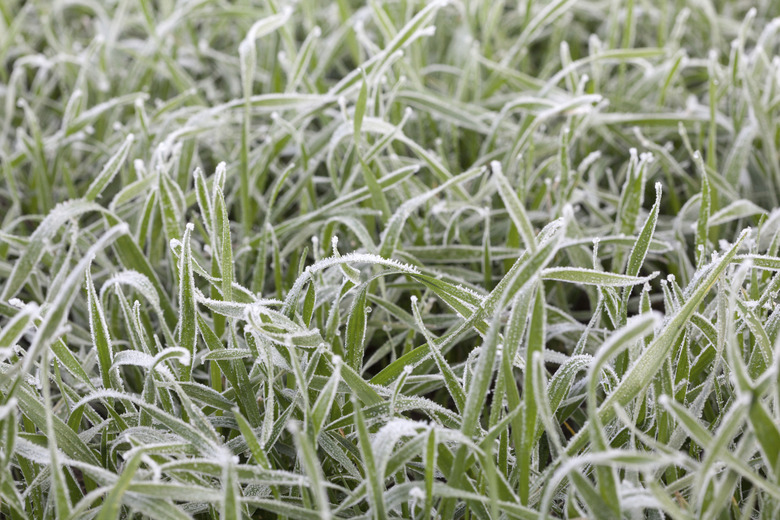How To Successfully Plant Winter Ryegrass
If you live in a region where the warm-season grass turns brown in the wintertime, ryegrass (_Lolium spp._) can give you a spring-like green lawn even in January and February. Although annual ryegrass (_Lolium multiflorum_) grows in all climate zones of the United States and perennial ryegrass grows in U.S.
If you live in a region where the warm-season grass turns brown in the wintertime, ryegrass (Lolium spp.) can give you a spring-like green lawn even in January and February. Although annual ryegrass (Lolium multiflorum) grows in all climate zones of the United States and perennial ryegrass grows in U.S. Department of Agriculture plant hardiness zones 3 through 6, you can overseed with annual or perennial ryegrass for a green winter lawn in USDA zones 7 through 10.
Prepare for Seeding
**Prepare the lawn for overseeding by aerating or removing excess thatch.** Purchase or rent a spike or plug aerator. Spike aerators roll across the lawn, punching holes in the ground. Plug aerators remove small cores of soil 2 to 3 inches deep every 2 to 3 inches.
Heavily thatched lawns can benefit from verticutting, which involves special equipment that makes vertical cuts at the base of the grass blades. For best results, verticut the lawn in one direction and then verticut across the lawn, making perpendicular cuts. Follow all directions provided with the machine.
- If you live in a region where the warm-season grass turns brown in the wintertime, ryegrass (Lolium spp.) Heavily thatched lawns can benefit from verticutting, which involves special equipment that makes vertical cuts at the base of the grass blades.
Aerate the lawn with a plug aerator approximately two months before the first frost date, when the lawn is moist. If you dethatch by verticutting, perform this operation just before seeding.
When to Seed
Plant ryegrass seed four to six weeks before the first killing frost or when daytime temperatures are in the 70s and nighttime temperatures are in the 50s. Make certain the ground is moist, such as the day after a rain or after irrigation, moistening the soil 6 to 8 inches deep.
Spreading Seed
**Grass seed must touch the soil to germinate,** so mow the lawn close and rake or bag all clippings before scattering seed with a spreader. For Bermudagrass (Cyntolon dactylon) lawns, use 5 to 10 pounds of annual ryegrass or 5 to 15 pounds of perennial ryregrass seed per 1,000 square feet of lawn. For St. Augustine (Stenotaphrum secundatum) or centipede (Eremochloa ophiuroides) lawns, use no more than 3 pounds of ryegrass seed per 1,000 square feet to reduce the possibility of damage to warm-season grass, recommends the NC Cooperative Extension.
- Aerate the lawn with a plug aerator approximately two months before the first frost date, when the lawn is moist.
- For St. Augustine (Stenotaphrum secundatum) or centipede (Eremochloa ophiuroides) lawns, use no more than 3 pounds of ryegrass seed per 1,000 square feet to reduce the possibility of damage to warm-season grass, recommends the NC Cooperative Extension.
Spread seed in one direction, such as east to west, and spread in the other direction, north to south, to ensure even coverage. Drag a rake or broom over the lawn to help grass seed make contact with the soil.
Water Requirements
**Water lightly and frequently to keep the top 1 to 2 inches of soil moist but not saturated.** Start right after seeding and continue light waterings up to several times per day while roots develop. Use a probe, such as a screwdriver, to check soil moisture depth.
Seeds need moisture to germinate, but **too much water can wash seeds away or encourage disease.** Gradually reduce waterings. After two or three mowings, water only often enough to prevent grass from wilting.
- Spread seed in one direction, such as east to west, and spread in the other direction, north to south, to ensure even coverage.
- After two or three mowings, water only often enough to prevent grass from wilting.
Ryegrass Maintenance
**Fertilize ryegrass overplanted in Bermudagrass any time from when it first emerges to after the second mowing.** Apply 10 pounds of 5-10-10 or 5 pounds of 10-20-20 fertilizer per 1000 square feet of Bermudagrass lawn or half that amount on other warm-season grass lawns.
Make additional fertilizer applications in November and February of a high-nitrogen, slow-release product, such as 4 pounds of 12-4-8 or 3 pounds of 16-4-8 on Bermudagrass, or half that amount on other grasses. Do not apply the second and third applications if you have had disease in your lawn to avoid exacerbating the problem, advises the NC Cooperative Extension.
**Keep your ryegrass lawn 2 to 4 inches tall,** removing no more than one-third of its height at one time. Mow only when the grass is dry.
